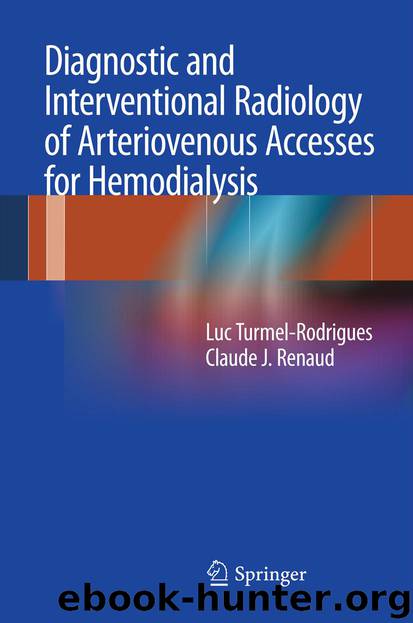Diagnostic and Interventional Radiology of Arteriovenous Accesses for Hemodialysis by Luc Turmel-Rodrigues & Claude J. Renaud

Author:Luc Turmel-Rodrigues & Claude J. Renaud
Language: eng
Format: epub
Publisher: Springer Paris, Paris
10.1.6.5 Superficialized Radial–Cephalic AVFs
Veins superficialized by either tunneling or transposition techniques develop stenoses at their terminal segment near the elbow. These skeletonized arterialized veins, devoid of their vasa vasorum, are more fragile and prone to rupture. Dilation of stenoses located in the cannulation zone carries a higher risk of skin rupture, and, therefore, deliberate underdilation with a 6-mm balloon should be the rule.
10.1.6.6 Ulnar–Basilic AVFs
These fistulas are not so common and typically develop stenoses at their peri-anastomotic and elbow areas [31]. Cannulation may be challenging in view of their posteromedial location in the forearm. The arm often needs to be flexed at the elbow in order to cannulate retrogradely new AVFs just like the nurses do during dialysis. Older fistulas are well developed enough to be cannulated at the wrist or elbow with the forearm kept extended and supinated (Fig. 7.3). Very exceptionally, the distal ulnar artery can be cannulated retrogradely. The arterialized basilic veins easily develop spasms in new fistulas and aneurysmal degeneration after a few years.
Download
This site does not store any files on its server. We only index and link to content provided by other sites. Please contact the content providers to delete copyright contents if any and email us, we'll remove relevant links or contents immediately.
| Administration & Medicine Economics | Allied Health Professions |
| Basic Sciences | Dentistry |
| History | Medical Informatics |
| Medicine | Nursing |
| Pharmacology | Psychology |
| Research | Veterinary Medicine |
Periodization Training for Sports by Tudor Bompa(7730)
Why We Sleep: Unlocking the Power of Sleep and Dreams by Matthew Walker(6154)
Paper Towns by Green John(4599)
The Immortal Life of Henrietta Lacks by Rebecca Skloot(4106)
The Sports Rules Book by Human Kinetics(3915)
Dynamic Alignment Through Imagery by Eric Franklin(3746)
ACSM's Complete Guide to Fitness & Health by ACSM(3681)
Kaplan MCAT Organic Chemistry Review: Created for MCAT 2015 (Kaplan Test Prep) by Kaplan(3649)
Introduction to Kinesiology by Shirl J. Hoffman(3491)
Livewired by David Eagleman(3402)
The River of Consciousness by Oliver Sacks(3265)
The Death of the Heart by Elizabeth Bowen(3181)
Alchemy and Alchemists by C. J. S. Thompson(3159)
Descartes' Error by Antonio Damasio(3032)
Bad Pharma by Ben Goldacre(2955)
The Gene: An Intimate History by Siddhartha Mukherjee(2766)
The Emperor of All Maladies: A Biography of Cancer by Siddhartha Mukherjee(2744)
The Fate of Rome: Climate, Disease, and the End of an Empire (The Princeton History of the Ancient World) by Kyle Harper(2689)
Kaplan MCAT Behavioral Sciences Review: Created for MCAT 2015 (Kaplan Test Prep) by Kaplan(2669)
